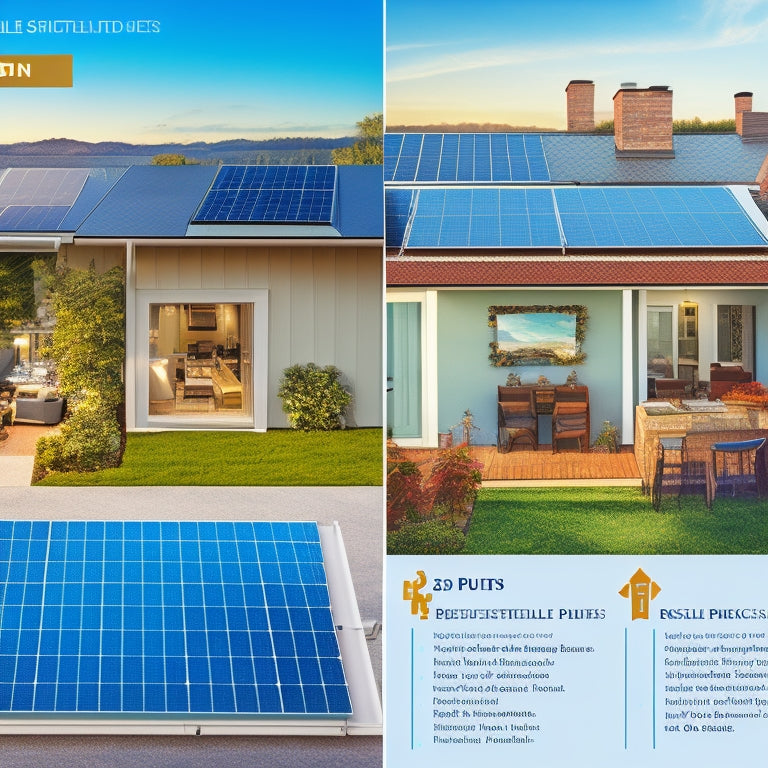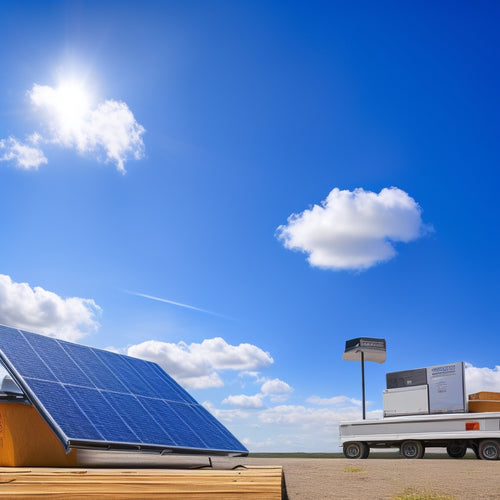
Why Do Residential Solar Panels Cost So Much?
Share
Your residential solar panel system's hefty price tag is largely due to the cumulative cost of numerous high-quality components, labor-intensive installation processes, and necessary administrative fees. You're paying for high-quality materials that guarantee efficient energy conversion and a long system lifespan. Skilled labor, specialized equipment, and time-consuming installation processes also drive up costs. Inverters, mounting hardware, and permits add to the expense. Additionally, features like battery backup systems, high-efficiency panels, and smart home integration premiums increase the upfront cost. As you continue, you'll discover the nuances of these factors and how they impact your investment.
Key Takeaways
• High-quality materials, skilled labor, and specialized equipment contribute to the high cost of residential solar panels.
• Complex installation processes, including site preparation and meticulous detailing, increase labor costs and time.
• Government regulations, permitting fees, and compliance with zoning regulations add to the overall cost of residential solar panels.
• Customized solutions, such as battery backup systems and specialized mounting hardware, drive up costs for residential solar panels.
• High-efficiency panels, inverters, and advanced robotics for installation also contribute to the premium pricing of residential solar panels.
High-Quality Solar Panel Materials
When investing in residential solar panels, you'll want to prioritize high-quality solar panel materials, as they directly impact the system's efficiency, durability, and overall performance. High-quality materials are vital to guarantee maximum energy output and a longer system lifespan.
Material durability is essential, as it directly affects the system's ability to withstand environmental factors like weathering, corrosion, and thermal stress. Manufacturing innovations have led to significant improvements in material durability. For instance, modern solar panels often feature advanced glass or polymer coatings that enhance scratch resistance and UV protection.
These innovations enable solar panels to maintain their efficiency over time, reducing the likelihood of premature degradation. Additionally, high-quality materials can help minimize the risk of hotspots, micro-cracks, and other defects that can compromise system performance.
Installation Labor Costs Add Up
As you consider the cost of residential solar panels, you'll find that installation labor costs can add up quickly. The skilled labor needed to guarantee a safe and efficient installation process doesn't come cheap, and the time-consuming process itself is a significant factor in the overall cost.
Moreover, specialized equipment needs can also drive up labor costs, making it essential to factor these expenses into your overall budget.
Skilled Labor Costs
Your total solar panel installation cost includes the labor costs of skilled professionals, such as electricians and roofers, who charge by the hour or by the project, adding up to a significant portion of the overall expense. These skilled professionals require extensive training, often through labor unions or workforce development programs, to guarantee they meet industry standards.
Here are some key factors contributing to the high labor costs:
-
Specialized tools and equipment: Solar panel installers need specialized tools and equipment, such as aerial lifts and wire strippers, which can be expensive to purchase and maintain.
-
Physical demands: Installation work can be physically demanding, requiring installers to lift heavy panels, climb ladders, and work in harsh weather conditions, leading to higher labor costs.
-
Liability insurance: Installers need liability insurance to protect themselves and their clients in case of accidents or property damage, adding to their overhead costs.
- Certification and licensing: Installers must obtain certifications and licenses, which require ongoing training and education, further increasing labor costs.
These factors contribute to the high labor costs, making up a significant portion of your total solar panel installation cost.
Time-Consuming Installation Process
The time-consuming installation process, which involves multiple stages, from evaluating your roof's structural integrity to configuring the system's electrical connections, drives up labor costs. As you prepare for the installation, you'll need to take into account weather conditions that may affect the process. Inclement weather can slow down the installation, adding to the overall cost.
Additionally, site preparation is crucial to guarantee a smooth installation. This includes clearing the area around your home, removing debris, and establishing a safe working environment.
Each stage requires meticulous attention to detail, and any mistakes can be costly. The installation team must carefully assess your roof's structure to determine the best placement of the panels. They'll also need to set up the system's electrical connections, ensuring a safe and efficient energy flow. These labor-intensive tasks require specialized skills, adding to the overall cost of the installation.
When evaluating the benefits of residential solar panels, it's important to take into account the time-consuming installation process and its impact on the overall cost.
Specialized Equipment Needs
You'll need specialized equipment, such as hydraulic lifts, cranes, or aerial devices, to safely and efficiently install your residential solar panels, which increases labor costs. This equipment is necessary to navigate complex roof structures, guarantee precise panel placement, and secure installation. The cost of renting or purchasing this equipment is factored into your overall installation cost.
To give you a better idea, here are some examples of specialized equipment you might need:
- Hydraulic lifts to reach high roofs or navigate multiple-story buildings
- Cranes to lift heavy equipment or panels onto the roof
- Aerial devices, such as bucket trucks, to access hard-to-reach areas
- Advanced Robotics to streamline the installation process and reduce labor costs
These specialized tools enable installers to work efficiently and effectively, ensuring a high-quality installation that meets energy storage requirements.
With the integration of advanced robotics, the installation process becomes even more streamlined, reducing labor costs and increasing the overall value of your residential solar panel system.
Inverter and Mounting Hardware
How efficiently your solar panels convert sunlight into usable energy largely depends on the quality and compatibility of the inverter and mounting hardware.
A high-quality inverter is essential, as it converts DC power from your solar panels into AC power for your home. Look for an inverter with grid flexibility, allowing it to adapt to changing grid conditions and ensuring a stable energy supply. You'll also want to make sure your inverter is durable and can withstand various environmental conditions.
When it comes to mounting hardware, you'll want to prioritize hardware durability. The mounting system should be designed to withstand harsh weather conditions, such as high winds and heavy snow loads. A well-designed mounting system will also ensure your solar panels are angled correctly, maximizing energy production.
Don't skimp on these components – a high-quality inverter and mounting hardware may seem expensive upfront, but they'll save you money and hassle in the long run. By investing in reliable and efficient components, you'll be able to harness the power of the sun with confidence.
Permitting and Inspection Fees
As you navigate the process of installing residential solar panels, you'll need to account for permitting and inspection fees, which can add up quickly.
You'll need to budget for permit application costs, which vary by locality, and local government fees, which can be substantial.
Additionally, you'll want to factor in potential delays in the inspection process, which can impact your project timeline and bottom line.
Permit Application Costs
When installing residential solar panels, homeowners must factor in permit application costs, which can range from $500 to $2,000 or more, depending on the jurisdiction and complexity of the project. These costs can be substantial, and it's important to factor them into your overall budget.
The government bureaucracy involved in the permitting process can be overwhelming, and the application complexity can vary greatly depending on the location and type of installation. You'll need to navigate through a maze of paperwork, inspections, and approvals, which can be time-consuming and costly.
Here are some factors that can impact permit application costs:
- Number of inspections required
- Type of electrical permit needed
- Complexity of the system design
- Jurisdiction-specific fees and regulations
Keep in mind that these costs can add up quickly, and it's crucial to plan accordingly.
Local Government Fees
You'll need to factor in local government fees, which can range from a few hundred to several thousand dollars, depending on the jurisdiction and type of solar panel installation. These fees are necessary for obtaining the necessary permits and approvals before installing your solar panels. Local governments impose these fees to guarantee that your installation meets the required zoning regulations and building codes.
You'll need to pay for permits, which can vary in cost depending on the complexity of your installation. For instance, a simple rooftop installation might require a permit costing a few hundred dollars, while a more complex installation might require multiple permits totaling thousands of dollars. Additionally, you may need to pay for inspections, which can add to the overall cost.
It's essential to factor these fees into your overall budget to avoid any surprises down the line. Be sure to research the specific fees and regulations in your area to get an accurate estimate of these costs. By doing so, you'll be better prepared to navigate the permitting process and get your solar panels installed efficiently.
Inspection Process Delays
Delays in the inspection process can greatly impact your project timeline and budget, adding hundreds or even thousands of dollars to your overall cost. When you're waiting for inspectors to sign off on your solar panel installation, every day counts. Unfortunately, the inspection process can be slow and unpredictable, leading to costly delays.
Here are just a few factors that can contribute to inspection process delays:
-
Backlogged inspection schedules: Inspectors can only visit so many sites in a day, leading to a backlog of inspections and delays for homeowners like you.
-
Complexity of building codes: Ensuring that your solar panel installation meets local building codes can be a time-consuming process, especially if your installation requires special permits or variances.
-
Inspector training and expertise: If inspectors lack the necessary training or expertise to evaluate solar panel installations, it can lead to delays and mistakes.
- Weather and logistical issues: Inclement weather, traffic, and other logistical issues can all contribute to delays in the inspection process, adding to your overall cost.
These delays can add up quickly, increasing your costs and prolonging your project timeline. As you plan your solar panel installation, be sure to factor in the potential for inspection process delays and plan accordingly.
Battery Backup Systems Increase
As homeowners invest more in renewable energy, battery backup systems have become an essential component, increasing the overall residential solar panels cost. You're not just looking for a way to reduce your carbon footprint; you want to guarantee grid resiliency and energy security.
A battery backup system provides you with a reliable source of power during outages, giving you peace of mind and reducing your reliance on the grid. This added layer of security comes at a cost, however. The cost of a battery backup system can range from $5,000 to $15,000 or more, depending on the type and size of the system.
When you factor in the cost of the solar panels themselves, the installation, and other components, the overall cost of your residential solar panel system can add up quickly. However, with a battery backup system, you'll have the energy security you need to power your home, even when the grid goes down.
Roof Size and Complexity Matters
The size and complexity of your roof greatly impact the overall cost of your residential solar panel system. Larger, more intricate roofs require more panels, specialized installation, and additional labor. This is because roof architecture and design constraints can greatly influence the installation process.
For instance, consider the following scenarios:
- Steeply pitched roofs demand more specialized equipment and labor to guarantee safe installation.
- Roofs with multiple levels or skylights need customized panel placement to maximize energy harvesting.
- Roofs with unusual shapes or angles call for more complex system design and installation.
- Roofs with obstructions like vents or chimneys require additional planning and labor to work around these features.
As a result, the more complex your roof, the more you can expect to pay for your solar panel system. Your installer will need to factor in the added time, materials, and expertise required to navigate these challenges, driving up the overall cost of your system.
High-Efficiency Panel Premiums
You'll pay a premium for high-efficiency solar panels, which boast higher power output per unit area, typically above 20% efficient, and are often preferred for their space-saving design and maximum energy harvest. These high-performance panels come with a higher price tag due to premium pricing, which can add up to 10-20% to the overall cost of your solar panel system. The increased efficiency ratings of these panels, often above 20%, allow for more power generation per unit area, making them ideal for homes with limited roof space.
When considering high-efficiency panels, it's essential to weigh the benefits against the added cost. While they may provide more energy per unit area, the increased upfront cost mightn't be justified by the additional energy generated. You should carefully evaluate your energy needs and roof size to determine if high-efficiency panels are the best choice for your residential solar panel system.
Additional Features and Upgrades
Customizable features and upgrades can greatly enhance your residential solar panel system's performance, monitoring, and maintenance capabilities. These upgrades can make a substantial impact on your energy savings and overall experience.
Some notable upgrades to ponder include:
-
Smart Home Integration: Seamlessly connect your solar panel system to your smart home ecosystem, allowing for effortless monitoring and control.
-
Energy Monitoring Systems: Gain real-time insights into your energy production and consumption, optimizing your energy usage and identifying areas for improvement.
-
Advanced Inverters: Upgrade to high-efficiency inverters that maximize energy harvest and minimize losses, ensuring you get the most out of your solar panels.
- Premium Mounting Systems: Enhance the durability and aesthetics of your solar panel installation with premium mounting systems that secure a sleek installation.
These upgrades can greatly enhance your solar panel system's performance, but they come at an additional cost. As you weigh the benefits and drawbacks, contemplate how these features align with your energy goals and budget.
Frequently Asked Questions
Can I Install Solar Panels Myself to Save Money?
If you're considering DIY installation to cut costs, be aware that lacking DIY expertise may lead to safety concerns, such as electrical shock or fires, and potentially void your warranty, so it's important to weigh the risks.
Are There Any Financing Options for Solar Panel Systems?
You're investing in a cleaner future, but upfront costs are steep. Fortunately, solar loans and panel financing options abound, allowing you to harness the sun's power without breaking the bank.
Do Solar Panels Work Efficiently in Shaded Areas?
You'll notice solar panels struggle in shaded areas, as energy loss increases. However, shade-tolerant panels can mitigate this issue, minimizing energy loss and ensuring you still harness considerable power from available sunlight.
Can I Add More Panels to My Existing Solar System?
Imagine upgrading your car's engine to boost horsepower - similarly, you can upgrade your existing solar system by adding more panels to increase energy output, a system upgrade that's like supercharging your renewable energy production.
Do Solar Panels Increase My Property's Resale Value?
You'll be pleased to know that solar panels can boost your property's resale value, offering appraisal benefits and enhanced market appeal, making your home more attractive to potential buyers who value energy efficiency.
Related Posts
-

Why Choose Affordable Electric Scooters for Urban Commuting
By choosing an affordable electric scooter for urban commuting, you'll not only reduce your transportation costs by u...
-

Top Mountain Bike Electric Conversion Systems
When upgrading your mountain bike with an electric conversion system, you can choose from top brands like Mountain Tr...
-

7 Essential Tips to Buy Discounted Solar Panels Online
When purchasing discounted solar panels online, you'll want to research top brands like SunPower, Panasonic, and LG, ...


